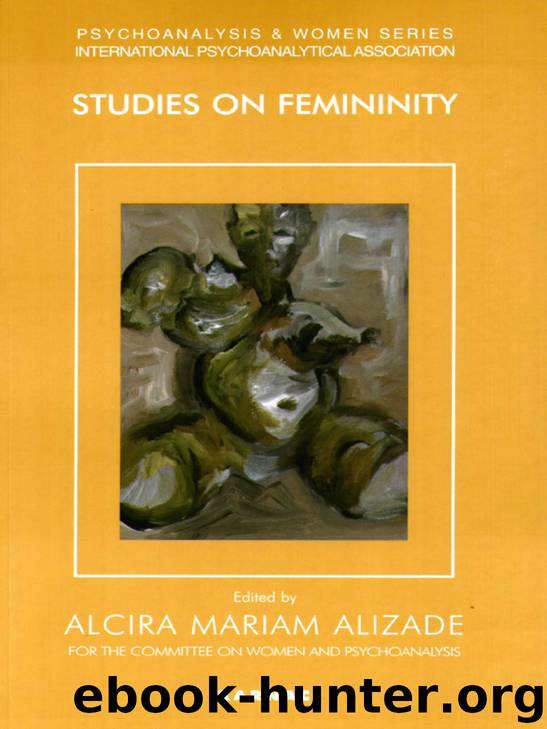Studies on Femininity by Mariam Alizade

Author:Mariam Alizade
Language: eng
Format: epub
Publisher: Karnac Books
Winnicott and bisexuality
While many post-Freudian authors use the concept of bisexuality, but without giving it a definitive theoretical status, different consideration must be given to D. W. Winnicott who dedicates to the theme of the bisexuality of human nature some of his greatest and most inspired pages. However, his speculations and trends of thought are complicated and sometimes contradictory, and although they use the classic terminology, they often move away from the Freudian line of thought, without a clarification of all the subtle differences.
In Human Nature (1988; Chapter 1), he in fact speaks of a “part” of the opposite sex—above all, of a “feminine part” of men—that has not been repressed as Freud said (1919), but rather, split off; and this split off part, far from being the lonely imprisonment “of the subordinated sex”, would be a potential, dynamic enrichment for the life of the individual.
But then the discourse becomes confused. On the one hand he "agrees with the Freudian idea of a common line of development between boy and girl until the phallic phase (“in this stage [pregenital], males and females are not necessarily different”); but then he muddles up the theoretic picture by undoing the link between conflict and drive (“Ambivalence has to deal with the changes of the child’s Ego rather than with the development of the id or of the instinct”); thus he redeems corporeal “phases” and “erogenous zones”, not through the thrust of the drive vicissitudes, but according to the relative “phantasies” (although, evidently, these phantasies are, in their turn, to be interpreted according to his own personal views, and certainly not to be identified with the classical Kleinian concept of phantasy).
The parameters of “nature” and “culture” then become even more complicated, because while he speaks of human “nature”, he also says that the “part” of the opposite sex is in dialectic relation with the capacity to identify with the parents, and that this capacity of identification is in its turn dependent on culture.
In the case of little girls […] this [full genital capacity] is associated with the capacity for identification with the mother and with women, and in the cultures that turn to this capacity very early on […] the “male in the female” seems to be absent. But the male in the female is always present and important… [1988]
I think I can say that, to his way of thinking, human bisexuality rests not so much on biology as on the play of phantasy and on the multiple creative capacities of identification. More of a potentiality to be developed, then, rather than a conflict to be resolved through mutilations and renunciations. Thus, we can probably conclude that maturation and genitality for Freud and for Winnicott go in opposite directions.
But perhaps the divergence lies not so much in the idea of maturation as renunciation or as conquest of the “part” of the opposite sex; but in the fact that Freud speaks of sexuality and bisexuality as drive vicissitudes, while Winnicott moves in a pre-conflictual area
Download
This site does not store any files on its server. We only index and link to content provided by other sites. Please contact the content providers to delete copyright contents if any and email us, we'll remove relevant links or contents immediately.
The Rules Do Not Apply by Ariel Levy(4861)
On the Front Line with the Women Who Fight Back by Stacey Dooley(4824)
The Lonely City by Olivia Laing(4750)
Bluets by Maggie Nelson(4474)
The Confidence Code by Katty Kay(4187)
Three Women by Lisa Taddeo(3354)
Not a Diet Book by James Smith(3336)
Inferior by Angela Saini(3276)
Confessions of a Video Vixen by Karrine Steffans(3246)
A Woman Makes a Plan by Maye Musk(3203)
Pledged by Alexandra Robbins(3132)
Wild Words from Wild Women by Stephens Autumn(3092)
Nice Girls Don't Get the Corner Office by Lois P. Frankel(2995)
Brave by Rose McGowan(2786)
Women & Power by Mary Beard(2729)
Why I Am Not a Feminist by Jessa Crispin(2695)
The Clitoral Truth: The Secret World at Your Fingertips by Rebecca Chalker(2671)
The Girl in the Spider's Web: A Lisbeth Salander novel, continuing Stieg Larsson's Millennium Series by Lagercrantz David(2671)
A Burst of Light by Audre Lorde(2546)
